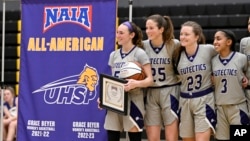Student Union
- By Alice Bryant
How to Speak Publicly Without Passing Out

Standing in front of other people and talking can be scary. It can make you feel more anxious if your presentation is not in your native language.
And what if you forget the words while you're speaking?
Anna Uhl Chamot, a retired professor at George Washington University, developed a method of teaching language. The method is called CALLA: Cognitive Academic Language Learning Approach.
Here strategy has three parts: planning, monitoring and self-evaluation.
No 1: Planning
Plan ahead and think about your main ideas. Make notes of the points you want to convey to your audience. Chamot says it is important to understand your subject. That way, you will be able to talk about your topic easily and with confidence.
“I know a lot of learners, and I mean not just learners of English but people in general, even native speakers, feel that they want to write out everything they’re going to say. This gives them some comfort,” Chamot says.
Once you are satisfied with the wording, go back and reduce the words to very short notes.
Also, prepare visuals on PowerPoint, Prezi or other computer program.
Chamot says each visual should have only a few points and words. That makes it easier for the audience to absorb the message of the visual.
Images or easy-to-see graphics without words are even better. If you give a presentation about a summer visit to Washington, D.C., your visual should show something exciting that takes place there.
That next step is practice. Practicing will remind you of the points you want to make.
Practice talking about each visual. The more you practice speaking about your topic, the easier it will be to talk in front of others.
Practice will also help you look up and away from your notes. It will help your voice be more lively and less monotone, or boring.
When you practice, do so in front of other people. An international organization called Toastmaster's offers support for people wanting to improve their public speaking. They offer a video library of advice and suggestions.
Chamot suggests recording yourself, too.
“Use a friend or a family member as your audience or/and practice in front of a mirror, looking at yourself, and turn on your smart phone and record yourself," Chamot says. "Then you can listen to what you really sound like.”
And, as you practice, imagine yourself in front of a real audience.
“Imagine in your head the audience, see all those faces and expressions and imagine that they’re there right in front of you.”
Chamot also recommends this tactic to open your presentation: Ask your audience a question.
For example, if your topic is summer activities in Washington, D.C., you might ask, “How many of you have ever gone to an outdoor concert in Washington, D.C.?”
Asking a question also makes a presentation more like a conversation and less like a lecture.
When you spend time preparing and practicing, you gain confidence and comfort and will feel less worry on presentation day.
Learning Strategy #2: Monitoring
The next strategy is monitoring: Monitoring is watching or listening to something to note its progress.
You should monitor yourself during your practice sessions and during the actual presentation.
During Practice:
To monitor during practice, Chamot says make a list of questions to ask yourself.
Some questions to ask yourself are: Did I state the topic and intent clearly at the beginning? Did I provide some examples and details? Did I restate the topic and conclusions at the end?
You will be more comfortable in front of your audience, she says, the more you practice.
During the Presentation:
When you’re in front of the real audience, monitoring can help you quickly identify issues and find solutions. For example, if you are nervous before the presentation starts, tell yourself silently that you are going to do well.
“Like, ‘I really worked hard on this. I know my PowerPoint looks good. I’m going to take a deep breath. And I have practiced so much. I know I can do this,’” she suggests.
And, if you forget English words during your presentation, you can substitute them with easier or different ones.
Other behaviors to take note of during your presentation are: Am I speaking too fast or too slow? Am I looking at my audience? Am I smiling from time to time?
Learning Strategy #3: Self-Evaluation
That brings us to Self-Evaluation, our third learning strategy.
In Self-Evaluation, you examine how well you did. It takes place after each practice session and after your actual presentation.
Chamot suggests these questions to ask yourself: Did I look at the audience enough? How much more do I need to practice? How well did I do?
Also ask yourself: What did I do well? What do I need to improve?
The strategies that worked well will help you do well next time.
If you understand your subject and use these helpful tools, it will become easier and easier to speak in public!
Do you dread speaking in public? Please leave a comment here, and visit us on Facebook, Twitter, Instagram and LinkedIn, thanks!
See all News Updates of the Day
With federal student aid delays, students aren’t sure what college will cost

The U.S. Department of Education’s federal student aid form (FAFSA) experienced serious glitches and delays this year.
Now, many students have been admitted to college, but don’t know how much money they’ll need to attend.
Read the story from Susan Svrluga and Danielle Douglas-Gabriel for The Washington Post. (March 2024)
Senator draws attention to universities that haven’t returned remains

More than 70 U.S. universities continue to hold human remains taken from Native American burial sites, although those remains were supposed to be returned 30 years ago.
Jennifer Bendery writes in Huffington Post that one senator has been using his position in an attempt to shame universities into returning remains and artifacts. (April 2024)
COVID forced one international student to go hungry

When Samantha (not her real name) enrolled in community college in the U.S., her family at home in South Africa scrimped and saved to support her.
But the COVID-19 pandemic hurt the family’s finances, and at one point Samantha had four on-campus jobs just to make ends meet. Many in the U.S. believe international students are wealthy sources of funding for universities, but stories like Samantha’s suggest otherwise.
Andrea Gutierrez reports for The World. (March 2024)
Tips for paying for a STEM degree as an international student

For US News & World Report, Melanie Lockert describes how to calculate the cost of a STEM degree, and where to find funding. (March 2024)
NAIA all but bans its transgender college athletes from women's sports

The National Association of Intercollegiate Athletics, the governing body for mostly small colleges, announced a policy Monday that all but bans transgender athletes from competing in women's sports.
The NAIA's Council of Presidents approved the policy in a 20-0 vote. The NAIA, which oversees some 83,000 athletes at schools across the country, is believed to be the first college sports organization to take such a step.
According to the transgender participation policy, all athletes may participate in NAIA-sponsored male sports but only athletes whose biological sex assigned at birth is female and have not begun hormone therapy will be allowed to participate in women's sports.
A student who has begun hormone therapy may participate in activities such as workouts, practices and team activities, but not in interscholastic competition.
"With the exception of competitive cheer and competitive dance, the NAIA created separate categories for male and female participants," the NAIA said. "Each NAIA sport includes some combination of strength, speed and stamina, providing competitive advantages for male student-athletes. As a result, the NAIA policy for transgender student-athletes applies to all sports except for competitive cheer and competitive dance, which are open to all students."
There is no known number of transgender athletes at the high school and college levels, though it is believed to be small. The topic has become a hot-button issue for those for and against transgender athletes competing on girls' and women's sports teams.
At least 24 states have laws barring transgender women and girls from competing in certain women's or girls sports competitions. Last month, more than a dozen current and former college athletes filed a federal lawsuit against the NCAA, accusing the sports governing body for more than 500,000 athletes of violating their rights by allowing transgender women to compete in women's sports.
The Biden administration originally planned to release a new federal Title IX rule — the law forbids discrimination based on sex in education — addressing both campus sexual assault and transgender athletes. But earlier this year, the department decided to split them into separate rules, and the athletics rule now remains in limbo even as the sexual assault policy moves forward.
Hours after the NAIA announcement, the NCAA released a statement: "College sports are the premier stage for women's sports in America and the NCAA will continue to promote Title IX, make unprecedented investments in women's sports and ensure fair competition for all student-athletes in all NCAA championships."
The NCAA has had a policy for transgender athlete participation in place since 2010, which called for one year of testosterone suppression treatment and documented testosterone levels submitted before championship competitions. In 2022, the NCAA revised its policies on transgender athlete participation in an attempt to align with national sport governing bodies, following the lead of the U.S. Olympic and Paralympic Committee.
The three-phase implementation of the policy included a continuation of the 2010 policy, requiring transgender women to be on hormone replacement therapy for at least one year, plus the submission of a hormone-level test before the start of both the regular season and championship events.
The third phase adds national and international sport governing body standards to the NCAA's policy and is scheduled to be implemented for the 2024-25 school year on August 1.
There are some 15.3 million public high school students in the United States and a 2019 study by the CDC estimated 1.8% of them — about 275,000 — are transgender. The number of athletes within that group is much smaller; a 2017 survey by Human Rights Campaign suggested fewer than 15% of all transgender boys and transgender girls play sports.
The number of NAIA transgender athletes would be far smaller.








